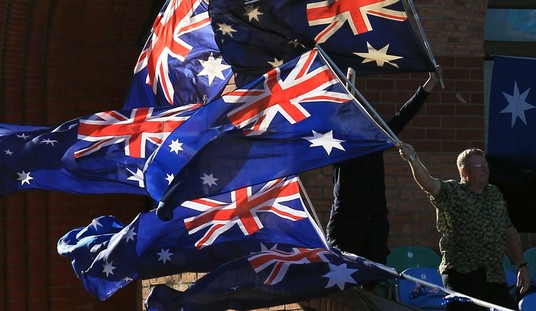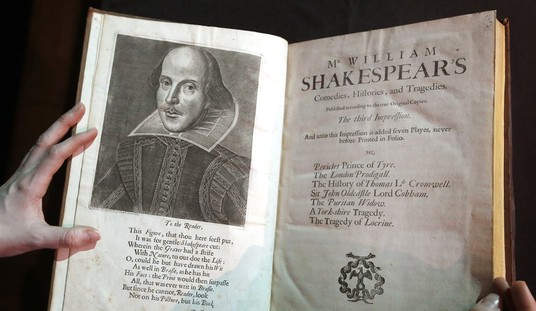Editor’s Note: This is an expansion of Kyle Smith’s list of the 10 best films of the 1940s published here in July. I’ve asked Kyle to expand his series as PJ Lifestyle begins offering more lists, articles, essays, and blog posts exploring culture, art, technology, and history by decade. Last month he expanded his ’80s list to a top 20 here, his ’60s list here, and his ’50s list here. Do you disagree with Kyle’s choices? Do you have your own ideas for lists of movies or other cultural subjects? Which years and what subjects would you most like to see covered at PJ Lifestyle? Email: DaveSwindlePJM [@] gmail.com. Also check out Kyle’s top 10 movie picks for the ‘30s, ‘70s, ’90s, and the ’00s before he expands them to top 20s. Click here to read “What Makes a Great Movie?,” Kyle’s essay explaining his criteria for these lists.
In the 1940s, patriotic films meant to rally the nation competed for attention with escapist fare and wonderfully felt nostalgia, but some of the best films of the decade are the uncharacteristically dark ones that were far ahead of their time. Here’s one critic’s expanded list of the 20 best films of the decade.
20. Red River (1948)
An ambitious rancher (John Wayne) and the boy (Montgomery Clift) he adopts and turns into his heir clash on a massive cattle drive north on the Chisholm Trail. Howard Hawks’s film is a rambling, broad-shouldered Western that captures the courage, resourcefulness, self-sacrifice and the sometimes extreme measures involved in the building of great American fortunes. Wayne’s thorny, complicated hero give the lie to those who would claim his performances lacked depth.
19. The Palm Beach Story (1942)
One of the handful of screwball comedies that are still hilarious today, this Preston Sturges jewel starred Joel McCrea and Claudette Colbert as a feuding society couple who split up and each take a train from Manhattan to Florida. The snappy pacing, zingy dialogue and insidery take on the nuttiness of the aristocracy of which Sturges was a born member would rarely be equalled.
18. The Great Dictator (1940)
Charlie Chaplin’s often painfully earnest political messages in his silent movies date them, but his freewheeling, satiric take on Adolf Hitler in this late-career talkie holds up. Among the first Hollywood movies to take on Der Fuehrer, this farcical but barbed attack on “Adenoid Hynkel” and fellow dictator “Benzino Napaloni” was not only funny but groundbreaking in the way it used comedy to demand more attention be paid to the plight of European Jews.
17. The Treasure of the Sierra Madre (1948)
Taking a break from his usual roles as the crusty cynic with a big heart, Humphrey Bogart is much darker here, playing the part of a gold seeker in the Mexican hills with a demonic glint of paranoia and murder in his eyes. He, Tim Holt and Walter Huston enact Walter’s son John Huston’s startling vision of a combination morality play and ripping adventure yarn.
16. Great Expectations (1946)
Still the best, most moving and most honest Dickens adaptation ever filmed, David Lean’s version of perhaps the most streamlined of the master’s novels provided an early glimpse of Lean’s frequent collaborator Alec Guinness as the best friend of protagonist Pip (John Mills), the boy whose simple kindness to a starving prisoner proved to be his making, but who transgressed by forgetting about his humble roots.https://www.youtube.com/watch?v=ecjzal-wlKQ
15. Going My Way (1944)
Gentle, cool, sardonic and wise, Bing Crosby was the biggest movie star of his era and he found the perfect role in this wartime drama about an unorthodox priest whose youthful methods gradually endear him to a group of misbehaving boys who seem headed for prison but whom the priest steers into becoming a church choir instead. Crosby’s wry detachment kept this emotionally rich film sentimental without being treacly.
14. Suspicion (1941)
Cary Grant gave his happy-go-lucky charm a sinister turn in this classic Hitchcock noir in which Joan Fontaine slowly begins to fear that her free-spending playboy husband might be planning to kill her for her insurance. Hitchcock and Grant keep you guessing all the way whether she’s right as director and star conspire to create one of the screen’s most diabolically attractive characters.
13. Brief Encounter (1945)
Lean’s later career as a director of splashy widescreen epics could never have been guessed from this almost unbearably exquisite, restrained chamber piece about two tender souls (Trevor Howard and Celia Johnson) trapped in lackluster marriages who find each other in a train station cafe and hesitantly take steps toward a love affair. Lean charts every step of their deepening romance with such studied craftsmanship that the payoff is overpowering.
12. The Lost Weekend (1945)
Early audiences thought the film was a comedy: That’s how unheard-of it was for director Billy Wilder and star Ray Milland to dare to take on the topic of alcoholism in a film. Milland’s clipped desperation as he rationalizes his need for booze wins over the audience’s sympathy, and though Wilder was rarely celebrated for his visual flair the fantasy scene about his protagonist’s battle with delirium tremens is a knockout.
11. The Grapes of Wrath (1940)
Perhaps the most effective liberal propaganda film ever made, John Ford’s adaptation of the John Steinbeck novel followed the trials of the suffering family of Tom Joad (Henry Fonda) as they, seeking only to work, fled the Dust Bowl west to California, only to find themselves treated as barely human when they got there. Disagree with it or not, the stark poignance of Fonda’s “I’ll be there” monologue became the standard against which all left-wing political speeches should be measured.
10. Double Indemnity (1944)
Director Billy Wilder and co-author Raymond Chandler set the standard for tantalizing film noir with this cynical, funny, slick and speedy tale of a shady insurance salesman (Fred MacMurray) and a married femme fatale (Barbara Stanwyck) who plot to kill her husband. Marred by some improbable machinations bringing in less interesting subsidiary characters in the third act, the film saves some of its best stuff for the end, winding up with a classic interplay between MacMurray and Edward G. Robinson.
9. Meet Me in St. Louis (1944)
This sweet remembrance of turn-of-the-century American life hit as Americans were holding their breaths about the outcome of the wars in Europe and the Pacific. Though the film’s Halloween sequence is a bit baggy, the start and the last act are suffused with golden familial tenderness and an endearing longing for a simpler time that maybe was never quite as simple as it seems. Who can forget Grandpa rescuing Esther by being her date to the Christmas Eve dance? Or Esther singing “Have Yourself a Merry Little Christmas” to Tootie, one of the most touching musical numbers ever put on film? Audiences who hoped but couldn’t know that the war would end in less than a year would surely have wept at the line, “Next year all our troubles will be out of sight.”
8. Sullivan’s Travels (1941)
Preston Sturges’ masterpiece stars Joel McCrea as a socially conscious liberal Hollywood filmmaker who, inspired by a book called O Brother Where Art Thou?, decides to hit the road and pretend to be a hobo to see how the other half lives. What he learns is that making people laugh is a lot more rare than making people cry. This monumental satire of Hollywood cluelessness is also emotionally resonant and far ahead of its time in its respectful treatment of black Americans.
7. A Letter to Three Wives (1949)
Along with All About Eve a couple of years later, this is one of the Joseph L. Mankiewicz films that represented the summit of urbane wit at the movies. It’s equal parts drama, comedy and mystery, a story about three suburban wives away from home for the day who learn in a letter from the beautiful, cultured woman they all admire that she is running off with one of their husbands. But they, and we, won’t learn which one until the end. A young Kirk Douglas gives a particularly wised-up performance as one of the husbands.
6. His Girl Friday (1940)
Still the funniest and best romcom ever made, this lightning-speed newspaper saga is about a devilishly witty editor (Cary Grant) plotting to win back his ex-wife and best reporter (Rosalind Russell) before she leaves for her wedding to an amiable doofus (Ralph Bellamy). No film has zippier banter and the three leads and their love triangle created an everlasting template for the genre.
5. It’s a Wonderful Life (1946)
Jimmy Stewart radiated screen goodness and Frank Capra found him the perfect role in a film that, despite its reputation as “Capra-corn,” has unsettling dark elements of the kind that didn’t ordinarily pop up in family films of the era. The reason that knockout ending comes across so beautifully is precisely because Stewart and Capra genuinely have us anguished about the ruination of George Bailey.
https://www.youtube.com/watch?v=UQzZANZ4R14
4. Pinocchio (1940)
The Biblical underpinnings of the second and greatest film Walt Disney ever made give it a foundation of morality and gravitas lacking in the others. It remains profound and chilling all these years later.
https://www.youtube.com/watch?v=YDtVdsC1FOc
3. The Third Man (1949)
The shadows and moral murk of postwar Vienna echo the Graham Greene screenplay’s themes about notorious black-marketeer Harry Lime (Orson Welles) and the search for his killer led by his jaded friend Holly Martens (Joseph Cotten). Harry’s ferris-wheel speech about the decadent but brilliant Borgias and the organized but boring Swiss, the chase scene in the sewers and the quietly devastating ending are superlative moments in this complex, troubling noir.
https://www.youtube.com/watch?v=EJvlGh_FgcI
2. Casablanca (1942)
Ever notice that Hollywood hardly ever remakes the truly great ones? They won’t be remaking this one. Perfection can’t be improved upon, and it’s impossible not to laugh when you think of any of today’s actors trying on Humphrey Bogart’s white dinner jacket and attempting to play Rick, that consummate tough guy with a soft spot.
https://www.youtube.com/watch?v=zyv19bg0scg
1. Citizen Kane (1941)
Revolutionary in its photography, its storytelling and its editing, not to mention suspenseful and hugely entertaining, Orson Welles’s first film (which he co-wrote with Mankiewicz’s brother Herman, directed and starred in at the age of 25) is one to be savored again and again. Virtually every scene is a marvel in a gripping tale of friendship and overreach in which Cotten made the perfect foil for Welles’ indelible creation, the orphan turned media magnate turned failed politician turned recluse Charles Foster Kane.








Join the conversation as a VIP Member